 The remains of a woman buried with a rich array of heavy bronze jewelry have been unearthed in what is now the Republic of Khakassia, southern Siberia. The intact grave was discovered in the Askiz-17 burial ground and dates to the 8-10th century B.C.
The remains of a woman buried with a rich array of heavy bronze jewelry have been unearthed in what is now the Republic of Khakassia, southern Siberia. The intact grave was discovered in the Askiz-17 burial ground and dates to the 8-10th century B.C.
She was found in a small, relatively shallow burial pit attached to the western side of a stone mound whose central grave had been pillaged  centuries earlier. Only 30 inches deep, the pit managed to avoid being damaged or destroyed by the construction of highways and railroads that has taken a heavy toll on the visible structures of the prehistoric burial ground.
centuries earlier. Only 30 inches deep, the pit managed to avoid being damaged or destroyed by the construction of highways and railroads that has taken a heavy toll on the visible structures of the prehistoric burial ground.
The woman was placed in a supine position with her head in a southeastern orientation. Animal remains — the shoulder blade and front leg of a large  horned mammal — were tidily placed to the side of her left foot as funerary offerings. The broken blade of a bronze knife was laid next to them. A large round pottery vessel with an ornamented rim was placed next to her head. It is in fragments, smashed over time by the stone filling of the burial pit.
horned mammal — were tidily placed to the side of her left foot as funerary offerings. The broken blade of a bronze knife was laid next to them. A large round pottery vessel with an ornamented rim was placed next to her head. It is in fragments, smashed over time by the stone filling of the burial pit.
The bones are in poor condition, but they are still for the most part  articulated in their original anatomical order. It is what her bones are wearing that identifies her as part of the Karasuk culture, skilled metal workers renown for their high-quality bronze cast in wax.
articulated in their original anatomical order. It is what her bones are wearing that identifies her as part of the Karasuk culture, skilled metal workers renown for their high-quality bronze cast in wax.
A large bronze bracelet with checkered ornament was placed above her wrist, four fingers of her left hand had large bronze rings, each with two pearl-shaped bronze decorations.
 To each side of the woman’s skull were 3 temple rings; two triangle plates were next to her head.
To each side of the woman’s skull were 3 temple rings; two triangle plates were next to her head.
By her right elbow archeologists found a round bronze plate, 9 centimetre in diameter, and 8 small bronze buttons.
 Archaeologists believe this was a custom-made funerary set, not jewelry the woman would have worn during her lifetime. There are no signs of wear and tear, not even the small scratches you’d expect from any kind of use at all. The sheer weight of the jewelry would have made them uncomfortable and unwieldy to wear under regular ambulatory circumstances.
Archaeologists believe this was a custom-made funerary set, not jewelry the woman would have worn during her lifetime. There are no signs of wear and tear, not even the small scratches you’d expect from any kind of use at all. The sheer weight of the jewelry would have made them uncomfortable and unwieldy to wear under regular ambulatory circumstances.
 All pieces from the small buttons, which once adorned burial clothes that have long-since decomposed, to the massive bracelet are made in the same artistic style typical of the the Minusinsk Basin in the Late Bronze Age. They were likely cast to order from one foundry. Her entire outfit, clothes and jewels, was a matched set created by a single master bronzesmith to send the deceased off in a style befitting her wealth and high status.
All pieces from the small buttons, which once adorned burial clothes that have long-since decomposed, to the massive bracelet are made in the same artistic style typical of the the Minusinsk Basin in the Late Bronze Age. They were likely cast to order from one foundry. Her entire outfit, clothes and jewels, was a matched set created by a single master bronzesmith to send the deceased off in a style befitting her wealth and high status.

source
http://www.thehistoryblog.com/archives/62271
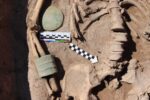
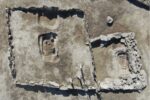
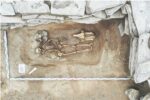

To each side of the woman’s skull were 3 temple rings; two triangle plates were next to her head.
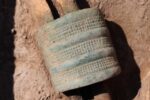



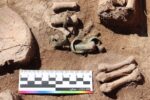






This comment has been removed by the author.
ReplyDelete